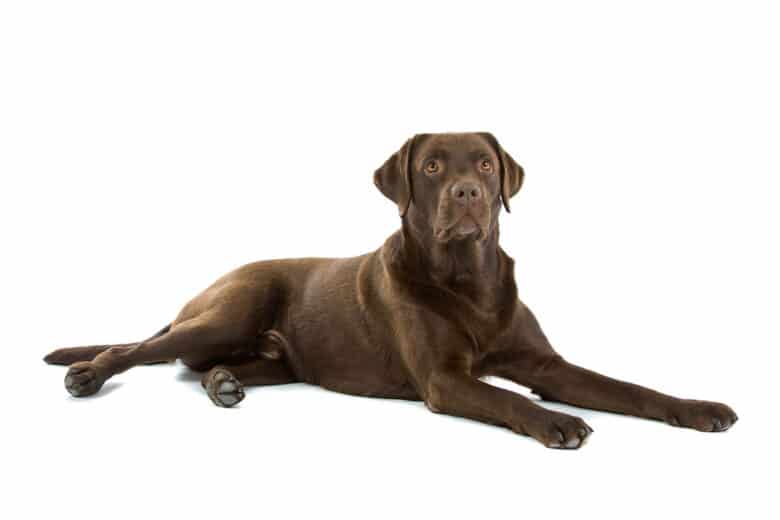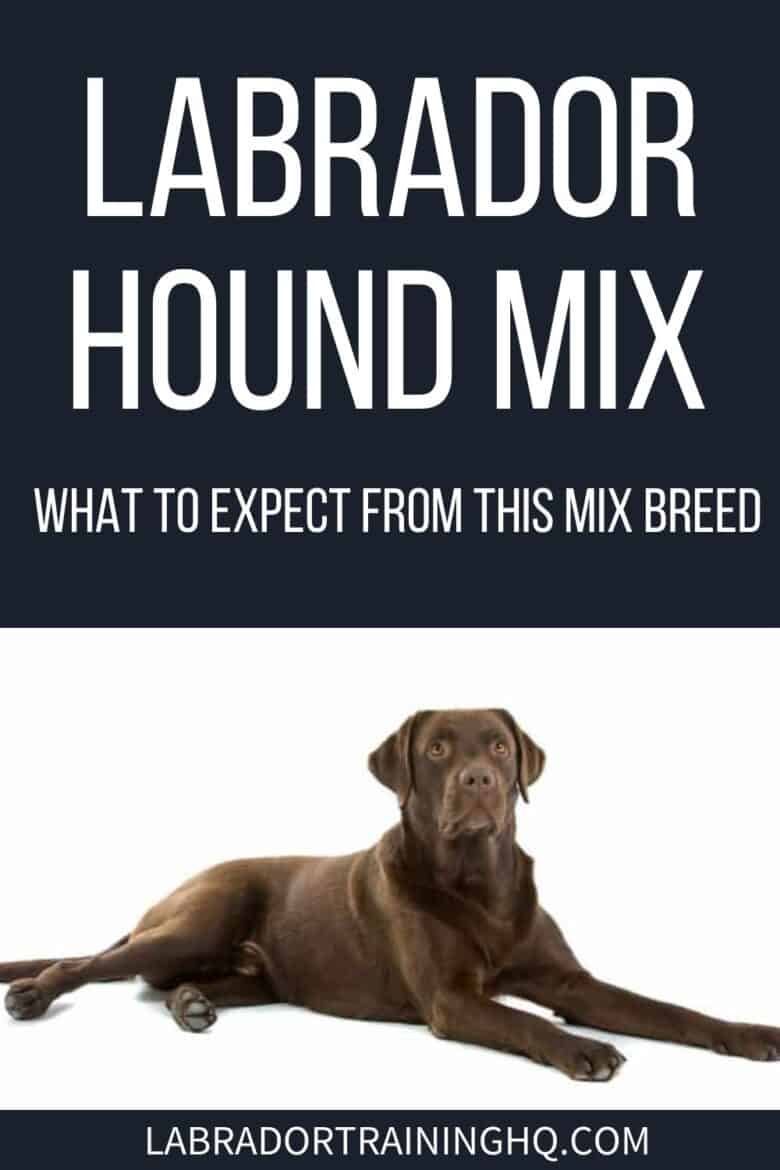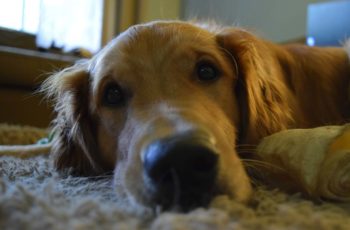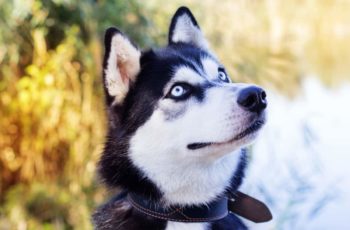This post may contain affiliate links. We may earn money or products from the companies mentioned in this post.
Labrador retrievers are one of the most popular dogs in the world, so you will find lots of mixed-breed dogs with a Labrador parent. One breed that is becoming increasingly popular is a Lab hound mix.
A Lab hound is a mix between a Labrador retriever and any dog from the hound family.
That means one of their parents could be a bloodhound, greyhound, Basset hound, Plott hound, or even a blue tick hound, so there is a lot of variation within this mixed breed.

These dogs tend to be loving and friendly pups ideal for families with lots of energy and love to give. Let’s take a closer look at exactly what to expect from a Lab hound mix!
Contents & Quick Navigation
Lab Hound Mix: History Of The Breed
Labrador retrievers have long been one of the most popular household pets in the United States. They were originally bred for retrieving game in wetlands, but their intelligence, eagerness to please, and innately friendly nature means they have also become popular in roles such as disability support.
The term “hound” is generally used to refer to dogs used by hunters to track prey. Unlike Labradors, which are used to retrieve prey, hounds use their instincts to track animals. The most well-known hounds are scent hounds, which use their keen sense of smell for tracking.
These dogs have also been trained to help with search and rescue to find missing people. There are also sighthounds, which tend to follow prey by sight and are faster to run down animals such as foxes and elks.
There are scores of different types of hounds. Among the most popular are the bloodhound, Basset hound, greyhound, Dachshund, and the Plott hound.
Mixing Labrador retrievers and hounds became a popular practice in the late 1980s and early 1990s when breeders started to mix a variety of breeds with Labs following the success of the Labradoodle.
The Labradoodle is a cross between a Labrador and a poodle, with the hope of having a Labrador’s intelligence and personality with the low-shedding coat of a poodle. Poodles are also highly intelligent and loving dogs, so Labradoodles quickly became popular as working dogs.
While Labradoodles and Boradors (a Labrador mixed with a border collie) are probably the most popular Labrador retriever mixes, Labradors mixed with Basset hounds, often called Basadors, are also becoming very popular.
Appearance
Lab hound mixes can vary greatly in size depending on the type of hound giving their DNA to the mix. Labradors are medium-to-large dogs measuring 21.5 to 22.5 inches tall and weighing between 55 and 80 pounds.
For example, if a Labrador is mixed with a Basset hound, a breed that rarely reaches 15 inches tall, they will be a lot shorter and stockier than a Lab.
On the other hand, if a Lab is mixed with a big bloodhound that can weigh up to 120 pounds and reach 28 inches in height, then you can expect a much taller and overall larger dog.
Alternatively, if the hound parent is a greyhound, you can expect another tall dog since they usually measure between 27 and 30 inches tall. However, you can expect the normally muscular body of the Lab to thin out since greyhounds are such slender dogs.
The appearance of a Lab hound is also often difficult to predict, but there are a few qualities you can expect regardless of the hound parent breed. Lab hound mixes usually have the face of a Labrador retriever mixed with the long ears of a scent hound. Most breeds of scent hounds have long ears to trap smells for tracking.
They might have more skin than usual and look a bit droopy like their bloodhound or Basset hound parent. But if the dog is part greyhound, you can expect them to have a more pointy face with no excess skin.
While Labradors tend to have a double coat that is short but thick, hounds typically have a single short coat. This means while Labrador retrievers shed a lot year-round, hounds tend to shed seasonally only, and their coat can easily be maintained with occasional brushing. Which of these two coat styles your dog will inherit is a bit of a gamble, though.
So, while you might be thinking of a Lab hound mix as a hypoallergenic alternative to a Lab, just be aware that you might strikeout in the genetic pool and end up with a pup with a high-shedding coat. Breeders do try to control this, but pups don’t always cooperate.
Lab hound pups will very often inherit the full-colored coat of their Lab parent, which could be black, chocolate, or yellow. But if their hound parent has a patterned coat, like the tri-color coats common among Basset hounds, their mixed-breed pups can have the same color or pattern.
Temperament
It might be fair to say that with a Lab hound mix, you can expect a dog with the personality of a Lab with their size, coat, and appearance to be more influenced by their hound parent. The same can be said when it comes to temperament; you generally will get a Lab with hound-like characteristics mixed in.
Labrador retrievers are highly intelligent dogs that can learn new tasks quickly and easily figure out what is wanted from them in new situations. Hounds are generally a bit less intelligent and intuitive, but they are just as capable of adapting and learning with the right training.
However, while Labs are very reward-driven and eager to please, hounds tend to be more independent and not overly concerned with pleasing humans.
This can make them a little bit stubborn and harder to train. It’s not that they don’t know what you want; they just might not want to give it to you. This is why some people say hounds are impossible to train.
Hound Lab mixes will be somewhere on the spectrum between highly trainable and incredibly stubborn, but it is impossible to predict which it will be until they have grown up a bit past the puppy stage.
Both Labradors and hounds tend to be very friendly dogs that love to play and prefer to make friends with small people and animals rather than chase them. This means they make terrible guard dogs, but they are excellent family pets.
While neither breed of dog tends to bark excessively and will only raise their voice to communicate with you, Hounds can have a tendency to bay or howl, which is a type of barking that many people find very annoying. Thankfully, they can be trained not to do this at inappropriate times.
Labradors are high-energy dogs. Hounds have a fair amount of energy, too, but they’re generally less active than Labs. If your Lab mix was bred with a small hound, you can expect them to not need much exercise, but if they are mixed with a larger breed like a bloodhound or a greyhound, they might need a bit more.
Any Lab hound mix will need at least 30 minutes of exercise a day, and larger mixes could need two to three times that amount.
The Lab hound’s high energy means they also don’t adapt well to apartment living and do best when they have a bit of outdoor space to call their own and can burn off energy throughout the day.
Their high energy levels also mean larger Lab hound mixes don’t mix well with younger children, even though they love them! Their energy can often be too overwhelming for both young children and new parents. However, older kids will probably enjoy the liveliness of the dog and helping to look after them.
Labs and hounds are both quite needy when it comes to human love and attention. They aren’t the types of dogs you can leave at home for ten hours a day while everyone is at work or school.
They tend to easily develop separation anxiety, which can manifest in destructive behavior like chewing and scratching furniture. Plus, since hounds have such a sharp sense of smell when they’re bored or frustrated, you can expect them to get into and destroy anything that smells tasty.
While hounds can be quite lazy and don’t mind lying around on the couch for several hours, separation anxiety is more about being apart from their people. As a result, they can still become troublesome, even if they usually sleep a lot when you are around.
Lab hound mixes do better in households where there is someone around most of the time, or even better, when they can accompany their principal companion on all their adventures. This includes the office during the week and hiking and swimming on weekends. Their Lab parentage means they will probably love a good swim.
Potential Health Risks
Lab hound mixes tend to have a slightly shorter lifespan than purebred Labs, usually living for around 11 to 13 years.
Lab hound mixes, especially larger ones, can be prone to hip and elbow dysplasia. This is a deformity of the joint that occurs when big dogs grow out of proportion. As a result, the hip or elbow joint doesn’t fit together quite right. This can cause them serious pain and mobility issues as they get older.
The best treatment for this is prevention by feeding and exercising them properly while growing. They should be provided with good quality food with lots of animal-based protein.
Be careful not to over-exercise your pup, despite their high energy levels. Until they are fully grown, they should only get about 5 minutes of exercise per day for every month of age. So, according to this general rule, a six-month-old pup needs only 30 minutes of exercise a day.
Vision problems are also fairly common among these dogs, and many will lose at least some of their sight as they age. Their long ears that can close their hearing passageways also make them prone to ear infections and hearing problems as they age. Regular ear cleaning is a must!
Both Labs and hounds love to eat, and they aren’t good at knowing when they are full. This means Lab hound mixes have a tendency to overeat and develop obesity when their diet is not strictly controlled.
Never leave food out for your pup to graze, and always maintain strict mealtimes with the right caloric proportions. If they need more energy, it is better to invest in better quality food rather than more food.
Evenly-spaced and well-portioned meals of high-quality dog food can also ensure your Lab hound mix doesn’t suffer from bloat, a condition that can become deadly very quickly. They also tend to have sensitive stomachs that don’t respond well to irritants, such as artificial additives in lower-quality foods.
Should I Adopt A Lab Hound Mix?
Having read our profile of the Lab hound mix, are you considering adopting one, but you’re still not sure if they are the right dog for you?
Ask yourself the following questions to help make your decision.
Do You Have A Lot Of Time To Spend With Your Dog?
Labradors and hounds both need a lot of time and attention. They need exercise, mental stimulation, and can’t be left alone for extended periods of time. They do best when they can join their humans on most of their adventures, whether this means accompanying you to work or joining you on a weekend hike. Will that fit your lifestyle?
Do You Have A Bit Of Space In Your Home?
Even smaller Lab hound mixes are pretty high-energy dogs, so they do best when they have some space to let off steam. These dogs aren’t ideal for apartment living, and they will be happiest with some outside space to call their own. They’ll also need to be taken on regular walks. Do you have the space for a Lab hound mix to feel comfortable?
Do You Have Experience Training Dogs?
While Labs are some of the most trainable dogs, hounds can be far more stubborn. This doesn’t mean first-time owners can’t handle them, but if you get a particularly stubborn pup and you don’t know what you are doing when it comes to training, you will probably need the services of a professional dog trainer.
Are you an experienced dog trainer, or are you willing to work with one if necessary?
Do You Have Small Children At Home?
While Lab hound mixes love children, their energy and attention can be a little intense for very young kids and new parents. Kids might find them overwhelming, and parents might struggle to juggle caring for young children and a rambunctious young Lab hound mix.
These dogs do better in houses with slightly older children who can keep up with their energy levels.
Lab Hound Mix FAQs
Are Lab Hound mixes good dogs?
Yes, Lab hound mixes are considered very good dogs because they are both intelligent and friendly. They love humans and make great companions. While they might be wary of strangers, they are more likely to want to make friends than make problems.
Is a Lab hound mix big?
The size of your Lab Hound mix depends mostly on the breed of hound that gives its DNA. If your dog is mixed with a relatively small hound like a Basset hound or a Dachshund, expect a smaller dog. But if your dog is mixed with a big hound like a bloodhound or an Afghan hound, expect a pretty big dog.
What is a Lab hound mix called?
There are a variety of different names for Lab hound mixes that depend on the type of hound that parents the pup. For example, a Basset hound Lab mix is often called a Bassador, while a Dachshund Lab mix is commonly referred to as a Dachsador.
Do hound mix dogs bark a lot?
Hounds don’t tend to bark for no reason, so you should expect hound mix dogs to be yappy dogs that bark excessively. However, most hounds were bred to give off a loud howling sound called baying when they have trapped or cornered their prey to alert hunters.
This sound can be ear-piercing if you aren’t used to hearing it and may be something that Lab hound mix dogs inherit.
Are hound mixes easy to train?
Hounds can be notoriously difficult to train. This is not because they can’t learn, but rather that they are highly independent and stubborn. Most hound dogs would rather be doing what they want to do, and they aren’t that concerned about pleasing you.
Labs, on the other hand, are very intelligent and eager to please. They are considered one of the most trainable dogs. So, you can expect a Lab hound mix to be a relatively trainable dog, though they may come with a few stubbornness challenges.
The Verdict
If you are looking for a Labrador mix that is slightly bigger or smaller than a purebred Lab with a good chance of having a low-shedding coat, you might want to consider a Lab hound mix.
Choose a mix with a Basset hound if you want a smaller pup or a bloodhound if you want a larger dog. In the end, whatever hound you choose, the resulting mix will be a loving and energetic dog.
These intelligent dogs will be a bit more stubborn than a Labrador, but they will also be happier to laze around with you rather than always needing entertainment.
Either way, the Lab hound mix is meant to be a companion. They need to spend lots of time with you and don’t like to be left alone.
You will struggle to find a better companion to join you and your family on all your adventures!
Have you ever had a Lab hound mix dog?
Share your experience with the community in the comments section below.
Save To Pinterest

Top Picks For Our Dogs
- BEST PUPPY TOY
We Like: Snuggle Puppy w/ Heart Beat & Heat Pack – Perfect for new puppies. We get all of our Service Dog pups a Snuggle Puppy. - BEST CHEW TOY
We Like: KONG Extreme – Great toy for heavy chewers like our Labrador Retrievers. - BEST DOG TREATS
We Like: Wellness Soft Puppy Bites – One of our favorite treats for training our service dog puppies. - BEST FRESH DOG FOOD
We Like: The Farmer’s Dog – A couple months ago we started feeding Raven fresh dog food and she loves it! Get 50% off your first order of The Farmer’s Dog.
For a list of all the supplies we get for our new service dog puppies check out our New Puppy Checklist on the PuppyInTraining.com blog.
Lab Hound Mix – Hunter Meets Retriever In This Mix Breed was last modified: November 24th, 2021 by


